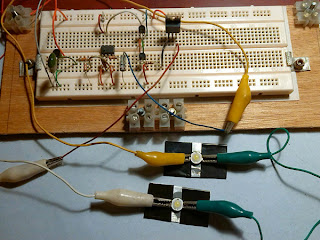In this project, we extend the shortwave superheterodyne receiver we developed a few years ago . Like the previous design, this receiver operates on the traditional superheterodyne principle. In this upgrade, we enhanced the local oscillator with Si5351 clock generator module and Arduino control circuit. Compared to the old design, this new receiver uses an improved version of an intermediate frequency amplifier with 3 I.F transformers. In this new design, we divide this receiver into several blocks, which include, mixer with a detector, a local oscillator, and an I.F amplifier. The I.F amplifier builds into one PCB. The filter stage, mixer, and detector stages place in another PCB. Prototype version of 455kHz I.F amplifier. In this prototype build, the Si5351 clock generator drives using an Arduino Uno board. With the given sketch, the user can tune and switch the shortwave meter bands using a rotary encoder. The supplied sketch support clock generation from 5205kHz (tuner f...


Comments
1 question though. 3w power leds are rated at 700 ma. why go for 500 ma?
1. Fix IRF9540 source and drain connections.
2. Add buck switcher output
circuit to IRF9540.
In the past, I've used TI's LM3410 sepic led driver with a aaa (1.5v), but the maximum constant current is about 700ma. I'm hoping to find something that gets closer to 1A.
Liner Technology developed several high current LED drivers (ex: LT3743, LT3476, etc.) but I never used them because these ICs are bit difficult to find in local market place (and even in eBay also).
the LEDs I have are,
LED, HIGH POWER, 5000K, 70CRI, 275LM
Series: LUXEON TX
LED Colour: White
Luminous Flux @ Test: 369lm
Forward Current @ Test: 1A
Forward Current If Max: 1.2A
Forward Voltage @ Test: 2.86V.
could you please help me what should be the specifications of the driver??